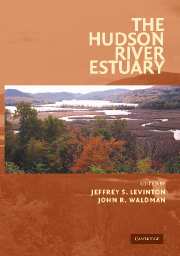Book contents
- Frontmatter
- Contents
- Preface
- List of Contributors
- The Hudson River Estuary
- 1 The Hudson River Estuary: Executive Summary
- GEOLOGICAL, PHYSICAL, AND CHEMICAL SETTING OF THE HUDSON
- 2 The Hudson River Valley: Geological History, Landforms, and Resources
- 3 The Physical Oceanography Processes in the Hudson River Estuary
- 4 Sedimentary Processes in the Hudson River Estuary
- 5 Benthic Habitat Mapping in the Hudson River Estuary
- 6 Reconstructing Sediment Chronologies in the Hudson River Estuary
- 7 Major Ion Geochemistry and Drinking Water Supply Issues in the Hudson River Basin
- PRIMARY PRODUCTION, MICROBIAL DYNAMICS, AND NUTRIENT DYNAMICS OF THE HUDSON
- HUDSON RIVER COMMUNITIES, FOOD WEBS, AND FISHERIES
- CONTAMINANTS AND MANAGEMENT ISSUES OF THE HUDSON RIVER ESTUARY
- Index
- Plate section
- References
7 - Major Ion Geochemistry and Drinking Water Supply Issues in the Hudson River Basin
Published online by Cambridge University Press: 06 January 2010
- Frontmatter
- Contents
- Preface
- List of Contributors
- The Hudson River Estuary
- 1 The Hudson River Estuary: Executive Summary
- GEOLOGICAL, PHYSICAL, AND CHEMICAL SETTING OF THE HUDSON
- 2 The Hudson River Valley: Geological History, Landforms, and Resources
- 3 The Physical Oceanography Processes in the Hudson River Estuary
- 4 Sedimentary Processes in the Hudson River Estuary
- 5 Benthic Habitat Mapping in the Hudson River Estuary
- 6 Reconstructing Sediment Chronologies in the Hudson River Estuary
- 7 Major Ion Geochemistry and Drinking Water Supply Issues in the Hudson River Basin
- PRIMARY PRODUCTION, MICROBIAL DYNAMICS, AND NUTRIENT DYNAMICS OF THE HUDSON
- HUDSON RIVER COMMUNITIES, FOOD WEBS, AND FISHERIES
- CONTAMINANTS AND MANAGEMENT ISSUES OF THE HUDSON RIVER ESTUARY
- Index
- Plate section
- References
Summary
abstract This chapter uses data from a few representative sampling sites in the Hudson basin to understand variations in major ion concentrations, which are used as one simple proxy of gross drinking water quality. Other water supply issues, including potential implications of dissolved organic carbon concentrations on drinking water quality, are also discussed. The major ion content of surface waters is largely determined by precipitation chemistry, dry deposition from the atmosphere, chemical weathering of rock and soil minerals, and anthropogenic loadings, and then modified by biogeochemical reactions that take place within the system. (1) Based on data reported for West Point, New York by the National Atmospheric Deposition Program (NADP), precipitation chemistry in the Hudson River basin is similar to that in much of the northeastern United States. As a result of upwind and regional fossil fuel combustion, sulfate and nitrate are the most abundant anions and hydrogen is the most abundant cation (i.e., dilute solutions of sulfuric and nitric acids). Ammonium, chloride, and sodium have lower concentrations, with the latter two derived mostly from marine aerosols. Chloride appears to have an additional, nonmarine, source accounting for at least 25 percent of wet deposition of this ion at West Point. (2) Major element chemistry of surface waters in the Hudson River basin strongly reflects bedrock geology of tributary catchments. Adirondack and Catskill Mountain and Hudson Highland streams have low total dissolved solids (TDS) typical of ancient crystalline, metamorphic, or previously weathered coarse silicic sedimentary formations. In contrast, the significantly higher TDS of the Mohawk River reflect drainage from large areas of sedimentary rocks including limestones, carbonate-rich shales, and evaporite minerals.
- Type
- Chapter
- Information
- The Hudson River Estuary , pp. 79 - 96Publisher: Cambridge University PressPrint publication year: 2006
References
- 3
- Cited by



